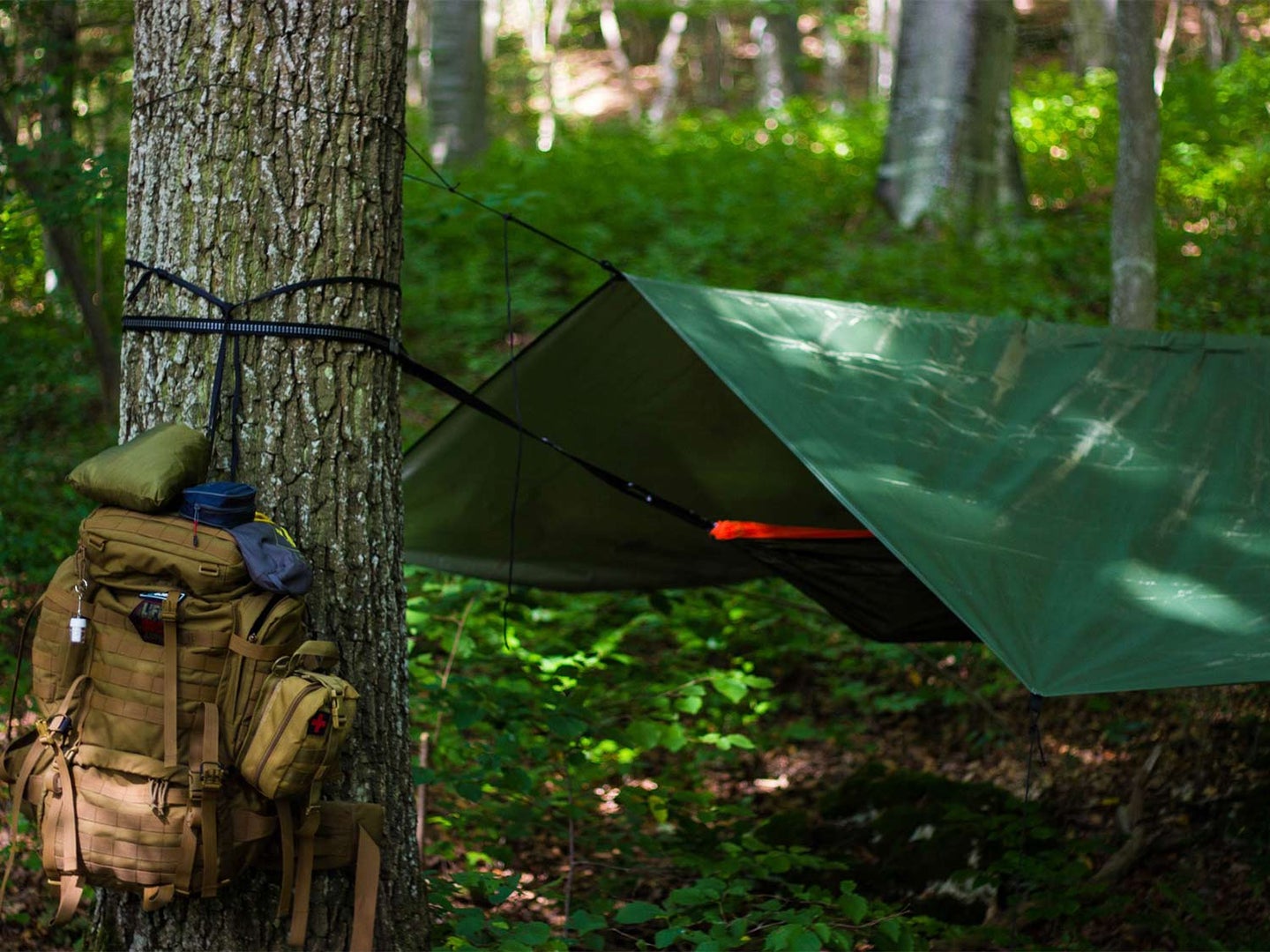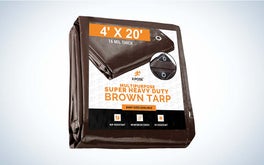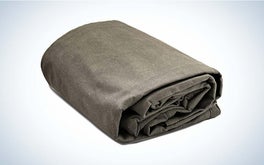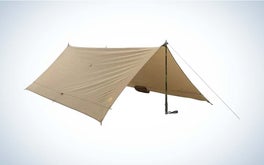We may earn revenue from the products available on this page and participate in affiliate programs. Learn more ›
A quality camping tarp is one of the most valuable and convenient pieces of gear you can take on your outdoor adventures. Whether you’re heading for the backcountry for two weeks of solitude or just down to the lake shore for an afternoon of fishing, a heavy-duty tarpaulin will make the experience more comfortable.
From a simple ground covering to a survival shelter, there are a few times when a tarp won’t come in handy for some purpose. An excellent waterproof tarp can protect you from rainstorms, keep your gear dry when the ground is wet, and act as a moisture barrier for your sleeping pad. Tarps aren’t created equal, and different types and construction materials are better suited for some jobs than others. Consider these various features when shopping for the best camping tarp for your outdoor adventures.
- Best Overall: WHITEDUCK Canvas Heavy Duty Tarp
- Best for Rugged Use: XPose Safety Super Heavy Duty 16 Mil Brown Poly Tarp
- Best for Backpacking: Sea to Summit Escapist Tarp
- Best for Hammock Camping: Kammock Kuhli Tarp
- Best for Car Camping: Kelty Waypoint Tarp
- Best Ground Tarp: REDCAMP Ultralight Tent Footprint
- Best Shelter: SJK Satellite Tarp
- Best Emergency Tarp: Lewis N. Clark Nylon Tarp
- Best Budget: Stansport Reinforced Brown Rip-Stop Tarp
How We Chose The Best Camping Tarps
Choosing the best camping tarp, like any outdoor gear, boils down to how you plan to use it. The best ground tarp may not be the best tarp to make a primary shelter, but there are plenty of versatile tarps that may work for both. Looking at the buying considerations is always a part of the decision-making process, but we also evaluate products based on the following:
- Durability: how long is the tarp expected to last? Are there cleaning and storage instructions to help it last longer? Does the company provide information on repair? Is there a warranty?
- Versatility: can the tarp be used for a variety of purposes?
- Sustainability: what materials is the tarp made out of? Can those materials be repurposed or recycled? Does the company accept returns or damaged tarps to be disposed of properly? What type of waterproof coating is utilized?
- Customer Service: is the company responsive to customer questions and concerns? Are they transparent about the manufacturing process and what can be expected from the product?
Other factors influencing our recommendations include some personal experience with some products, verified customer feedback, and company-specific research.
The Best Camping Tarps: Reviews & Recommendations
Best Overall: WHITEDUCK Canvas Heavy Duty Tarp
Why It Made The Cut: The WHITEDUCK Canvas Tarp is a durable, versatile 4-season tarp that you can trust regardless of activity or the weather.
Key Features
- Weight: varies depending on size
- Dimensions: 6×8, 7×9, 8×10, 10×12, 12×16, 16×20, 20×20
- Materials: loomstate heavy duty 18 oz. numbered duck cotton canvas fabric with wax treatment
Pros
- Four season protection
- Available in several sizes
- Durable materials
- Versatile
Cons
- Not the best option for backpacking
This rip-resistant, WHITEDUCK Canvas Tarp has rust-proof grommets, and its seams and hems are double stitched with rot-resistant thread, ensuring a long and useful life. Since it is made from canvas material, it is heavier than other tarps commonly made from synthetics. Finding a quality tarp made from mostly natural materials is difficult, but this one affords a high level of durability and functionality.
Since there are several size options, you can tailor the tarp to your needs. Even though this isn’t a top choice among backpackers, we like it for basecamping, car camping, and overlanding. The reinforced grommets make a secure shelter, and the wax-treated canvas provides excellent gear coverage when sudden storms arise.
Another benefit of a canvas tarp is that it tends to be much easier to repair if a rip does appear. All tarps can be repaired to an extent, but rips can significantly impact the integrity of the materials, especially if it tears near a seam or grommet. Canvas allows for a stronger patch, giving the tarp better overall longevity.
Best for Rugged Use: XPose Safety Super Heavy Duty 16 Mil Brown Poly Tarp
Why It Made The Cut: The XPose Safety Super Heavy Duty Tarp is a 16mm thick, waterproof tarp that is ready to provide you with the ultimate outdoor protection.
Key Features
- Weight: 8 oz per square yard
- Dimensions: 4×20, 6×8, 6×20, 8×10, 10×10, 10×12, 10×20, 12×16, 12×20, 12×25, 12×30, 12×40, 15×15, 15×40, 16×20, 18×24, 20×20, 20×30, 20×40, 24×36
- Materials: Polyethylene (PE)
Pros
- Weatherproof materials
- Reinforced corners for added durability
- Multipurpose use
- Rip resistant materials
- Available in several sizes
Cons
- Thick materials make it heavy
The XPose Safety super heavy-duty camping tarp is made of extra-thick material that can stand up to rugged use and is UV-resistant. It comes in various sizes, so you should be able to find the one that’s right for you. From a ground cover for a small tent to a rain and snow fly for a hunting camp or a cover for the woodpile over the winter, this tarp can do it all.
Utilizing extremely durable polyethylene materials and metal grommets, the rip-resistant fabric lasts much longer than a standard tarp. Being UV resistant helps prevent premature breakdown when used outdoors or left to sit in the sun.
The grommet space is also ideal for making shelters of all kinds, which can be an excellent choice for a tarp tent. The all-weather protection gives you peace of mind while camping in any season. If durability is your main concern, then the Xpose Safety Tarp should be a top consideration.
Best for Backpacking: Sea to Summit Escapist Tarp
Why It Made The Cut: The Sea to Summit Escapist Tarp is an ultralight, versatile camp shelter fitting for the minimalist backpacker, especially when paired with their bug tent.
Key Features
- Weight: 10.5 oz, 15.5 oz
- Dimensions: 8×6, 10×10
- Materials: 15 denier Ultra-Sil Nano
Pros
- Can be secured for rain and wind
- Multiple setup options
- Ultralight
- Strong tie-out points
Cons
- Small
- Primary use is a shelter
If you are an ultralight backpacker or are looking for a shelter to have on hand for an emergency shelter, the Sea to Summit Escapist Tarp should be a go-to option. It is incredibly lightweight and can be packed down to be smaller than a standard Nalgene water bottle.
With such lightweight materials, you can make this your primary camp shelter or have it on hand as a mess shelter for cooking in the rain. Pair it with the Sea to Summit Escapist Bug Tent, and you have a full ultralight tent setup.
Although it only really functions as a shelter, there are multiple configurations to choose from, allowing you to make a shelter that best fits your needs at that moment. Overall, it is a highly functional and durable tarp you can’t go wrong with while backpacking.
Best for Hammock Camping: Kammock Kuhli Tarp
Why It Made The Cut: The Kammock Kuhli Tarp is the ideal way to stay dry while hammock camping and is versatile enough to be a general camping shelter.
Key Features
- Weight: 20.5 oz
- Dimensions: L 144 in x W 108 in
- Materials: Patagium™ 15D diamond ripstop nylon with Sil/PU + DWR waterproofing
Pros
- Adaptable shelter configurations
- Lightweight and packable
- Strong and sturdy when set up
- Comes with stakes and guylines
Cons
- Price
The Kammock Kuhli Tarp is the ultimate hammock camping tarp you can utilize as a basecamp shelter. It has seemingly endless setup configurations; no matter what, you can get a secure shelter. Unlike other guyline systems, this tarp also utilizes a knotless system, making setup and take down even easier.
For the standard hammock camper, this shelter will be deluxe. For other outdoor purposes, this can be used as an emergency shelter, a mess shelter, or a standard shade/rain shelter while in camp. It comes with Sil/PU and DWR coatings and sealed seams for even stronger moisture protection.
The price can be a bit daunting on this one, but the quality makes up for it. It is a durable tarp that provides protection against all weather conditions and is versatile enough to take along on any backcountry adventure.
Best for Car Camping: Kelty Waypoint Tarp
Why It Made The Cut: The Kelty Waypoint Tarp combines everything we love about a traditional tarp with a car awning, bringing your car camping setup to the next level.
Key Features
- Weight: 8.38 lbs
- Dimensions: L 132.68″ x W 165.35″
- Materials: 68 denier polyester
Pros
- Excellent protection area
- Attaches to most vehicle types
- Far more versatiile than standard square awnings
- Quick setup
- Affordable price
Cons
- Not as wide as a traditional awning
- Only really works with vehicles, not as a stand alone tarp
Take your dirtbagging to the next level with the Kelty Waypoint Tarp. Whether you’re enjoying a weekend getaway or life on the road, this tarp can extend your camp living situation so you can enjoy cooking and hanging out no matter the weather.
Unlike traditional square awnings, this tarp has a larger surface area that extends slightly down. The shape of the awning gives you far more wind, rain, and sun protection. The attachment points and general security of the tarp is excellent, and it functions with various vehicle types.
For what you are getting, the price is phenomenal. Overall, this is an excellent car camping accessory that is durable, practical, and easy to use.
Best Ground Tarp: REDCAMP Ultralight Tent Footprint
Why It Made The Cut: The REDCAMP Ultralight Tent Footprint is a versatile ground tarp that can also be used as a canopy if needed.
Key Features
- Weight: 8.96 oz
- Dimensions: 8.6” x 3.14”
- Materials: 210T Ripstop Polyester
Pros
- Affordable price
- Lightweight and Packable
- Multipurpose design
- Available in several sizes
Cons
- Not the most durable design, but versatile
While we recommend buying a ground tarp designed for your tent, the REDCAMP Ultralight Tent Footprint provides a relatively universal option. It is seemingly more affordable than many brand-specific footprints, making it a good budget option.
The simple design makes it the most functional tent footprint, but it can also be used as a picnic blanket or a canopy if preferred. It’s made from synthetic materials treated with a waterproof coating, so you don’t have to worry about moisture penetrating the tent’s floor.
It is lightweight and packable enough to add to your tent bag or into your backpack for use as a shelter. While traditional tarps can be used as a footprint, specialized ground tarps tend to be lighter and easier to pack, which may not be necessary depending on the camping you enjoy.
Best Shelter: SJK Satellite Tarp
Why It Made The Cut: The Slumberjack Satellite Tarp is an extremely versatile shelter with design features that make it feel more like a tent than a tarp.
Key Features
- Weight: 1 lb 10 oz
- Dimensions: 124″ x 103″
- Materials: 70 denier coated polyester
Pros
- Multiple configuration options
- Can fit 2 comfortably
- Durable materials
- Integrated storage pocket
Cons
- Heavier than other backpacking tarps
The Slumberjack or SJK Satellite Tarp is a simple yet functional backcountry shelter design. It has built-in guy points for staking out and comes with ten stakes so you can make a tight, secure tarp shelter. A hanging pocket allows you to keep small items off the ground, and the tarp stuffs into the pocket for easy transport.
Although it is a tad heavier than other backpacking tarp options, the materials are durable, making it worth a few extra ounces. Available in two color/pattern options, the tarp allows you to stealth camp, making it perfect for hunting or even as a small mess shelter at a spike camp.
It is straightforward to set up, and depending on the environment, the configurations can differ every time. Utilizing your trekking poles as tent stakes is a popular way of making this into an a-frame shelter, but you have many options beyond that.
Best Emergency Tarp: Lewis N. Clark Nylon Tarp
Why It Made The Cut: The Lewis N. Clark Tarp is a lightweight nylon tarp is constructed of 210D Oxford nylon for extreme durability, and reinforced grommets make cinching the tarp down a breeze.
Key Features
- Weight: 14.4 oz
- Dimensions: 8×6
- Materials: Nylon
Pros
- Affordable
- Simple design
- Functional materials
- More durable than a standard blue tarp
Cons
- Nothing special, just a tarp
This extremely durable tarp is lightweight and comes in a zippered carrying case for stowing in your pack. The 6×8-foot version is less than a pound so it won’t weigh you down on the trail. As far as tarps go, the Lews N. Clark Tarp is a standard tarp option. It is slightly more durable and lightweight than a cheap blue tarp you can get at Walmart, but other than that, it functions as a tarp.
Do not expect anything grand or extraordinary from this tarp, but it gets the job done, and you can depend on it. It isn’t very heavy for its size and overall durability, and the weather protection is decent. If you are willing to spend a few extra bucks, upgrade your emergency tarp to this one. It will provide better security and is less likely to wear down as quickly as other budget tarps.
Best Budget: Stansport Reinforced Brown Rip-Stop Tarp
Why It Made The Cut: The Stansport Tarp is a durable, rip-stop polyethylene tarp with laminated sides and is suitable for light use around home and camp.
Key Features
- Weight: varies according to size
- Dimensions: 6×8, 8×10
- Materials: Polyethylene (PE)
Pros
- Waterproof
- Relatively lightweight
- Durable for the price
- Rust resistant grommets
Cons
- It’s a cheap tarp, don’t set your expectations too high
If you need a tarp that gets the job done without spending much money, the Stansport Reinforced Ripstop Tarp is a great place to start. Available in a couple of size options, you can choose a tarp that best fits your needs.
Let’s be realistic, though; this is much like the classic blue tarp. These tarps are awesome, affordable, and accessible. They are waterproof but wear down over time, which also wears down their water resistance. Overall, this is a decent buy if you want a versatile tarp. Take care of it, and it will last you years of use both on and off the trail.
What to Consider When Buying The Best Camping Tarps
Since there’s a wide variety of tarps to choose from, it’s important to determine the intended use. If you’re going to be carrying it backpacking, it needs to be lightweight. If you’re going to be tying it down over gear or overhead, it should have enough grommets so that you can lash it properly.
If you’re going to use it as ground cover, it needs to be sturdy. It must have specific features for staking out if you want it to double as a tent. Different types of tarps excel in different situations and conditions, so you might find you need more than one tarp to meet all of your needs.
Do You Need a Tarp for Extremely Wet Conditions?
For those who enjoy the outdoors in rainy or damp environments, consider putting waterproof qualities ahead of all other factors when shopping for a tarpaulin. Some extra heavy-duty tarps are made to take hours and hours of hard rain without leaking. If you’re back in the boonies with nothing to do but wait out a rainstorm, those are the types of tarps you wish you had in your backpack with you.
If you’ll be out in the wet, consider a tarp made of strong and durable polyethylene. If your tarp is waterproof but can’t stand up to normal camp treatment, it’s going to be ripped when you need it most. Then, no matter how waterproof it is, you and your gear are going to get wet.
Do You Need a Heavy Duty Tarp?
If you’re camping in very rugged environments, you need a heavy-duty tarp. Look for a tarp made of tough material, so you don’t have to worry about it tearing or developing a hole. Tarps tend to be made from synthetic materials like vinyl-coated polyester or high-density polyethylene, but they can also be made from canvas.
The tarp thickness can also influence durability. Tent footprints or ground tarps generally are much thinner than a general use or shelter tarp. If the tarp is ultralight or for backpacking specifically, you can guess that they are thinner (2-5mm) and won’t last as long for general use.
Do You Need an All-Around Tarp?
When it comes to camping essentials and outdoor gear, the old saying applies: It’s better to have it and not need it than need it and not have it. That’s especially true when it comes to tarps.
Tarps can be used for so many different purposes during typical outdoor activities that it is mind-boggling. You can use one as a ground cover to keep water from leaking through your tent’s floor from below. You can set your packs, stoves, and other gear on a tarp to keep them off the wet ground. You can cover gear and firewood that could get wet if a rainstorm moves in overnight. You can even make a shelter out of a tarp. For these purposes, a camping tarp needs to be waterproof.
Will You Be Using the Tarp as a Shelter?
There are times in the outdoors when you unexpectedly need shelter. It might be to keep you out of the burning sun to avoid sunburn, to keep you out of a stinging wind that may cause you to become hypothermic, or to keep the rain off of you while you take a break and recharge.
A tarp is perfect for such use. Some experienced campers prefer to carry a tarp instead of a tent. When set up the right way, it provides most of the comfort of a typical camping tent. However, having the tarp instead of a tent cuts down on the weight you’ll carry, which is especially important for those backpacking or carrying their gear while portaging.
Some tarps specially made for creating shelters come complete with ropes, poles, and even stakes. You can use it as a standard tarp, deploy the poles, and make a tent.
Do You Need A Tarp For Emergencies?
A tarp can be a great help in cases when an emergency occurs far from home. As mentioned previously, a tarp can be used to make a shelter quickly if needed. You can throw one over your gear if a rainstorm pops up. You can use a tarp to wrap an injured or wounded companion for warmth and use it to carry an incapacitated person out of the woods. You can make a hammock out of a tarp if you need to get yourself off the ground. If your tent rips, stake a tarp over it to keep the interior dry. A tarp is a great thing to always have in your emergency kit.
FAQs
Q: How do you hang a tarp for camping?
You can hang a tarp for camping by tying one corner or side to trees and stake or weighing the other side/corners to the ground. Attach cords to the grommets on the side or corners, and tie them to trees or stake the cords down to keep it taut.
Q: Are camping tarps worth it?
Camping tarps are worth it, especially if you plan to use one as a part of your shelter. Camping tarps have many uses, from shade shelters, rain shelters, covering gear, or a ground tarp to protect the bottom of your tent. Invest in a tent that fits your intended use to get the most out of using it for camping.
Q: How much do camping tarps cost?
How much camping tarps cost greatly depends on the quality and intended use. You can get a tarp for as little as $5, or you can pay upwards of $150—the product materials, durability, size, versatility, and waterproofing all factor into the price.
Q: What kind of camping tarp should
I get?The kind of camping tarp you should get depends on your needs and how you plan to use it. When choosing a camping tarp, waterproofing and durability are two key things to look at. The versatility of the tarp may not be as pressing, but it is a nice perk. Read through our buying considerations to help you narrow down the best camping tarp for your needs.
Q: How thick should a camping tarp be?
How thick a camping tarp should also be can be determined by the intended use. For instance, a ground tarp only needs to be around 2mm thick, whereas, for general use, like covering items of use as shelter, 5mm thick or more is ideal.
Q: Is a tarp better than a tent?
In use as a shelter, tents offer better protection overall. Tarps are excellent for survival, ultralight setups, and hammock camping. Tents give full coverage from rain, and they seal, keeping out bugs and other pests. Tarps are more packable and have versatile uses, but tents often do a better job in terms of shelter.
Q: What is the strongest tarp material?
Tarps made from vinyl-coated polyester or high-density polyethylene are among the strongest and most durable options. Other tarps materials like canvas and nylon are also very strong but don’t always perform as well in packability and waterproofing.
Final Thoughts on the Best Camping Tarps
- Best Overall: WHITEDUCK Canvas Heavy Duty Tarp
- Best for Rugged Use: XPose Safety Super Heavy Duty 16 Mil Brown Poly Tarp
- Best for Backpacking: Sea to Summit Escapist Tarp
- Best for Hammock Camping: Kammock Kuhli Tarp
- Best for Car Camping: Kelty Waypoint Tarp
- Best Ground Tarp: REDCAMP Ultralight Tent Footprint
- Best Shelter: SJK Satellite Tarp
- Best Emergency Tarp: Lewis N. Clark Nylon Tarp
- Best Budget: Stansport Reinforced Brown Rip-Stop Tarp
Camping tarps can be used for various purposes, and it’s better to have one that isn’t perfect for your needs than not have one. Err on the side of too big instead of too small—you can always fold the excess over. Tarps aren’t expensive, so buying one is a worthwhile investment. Even if you didn’t find the best camping tarp for you on our list, reference our buying considerations to help you make the best choice for your needs.












